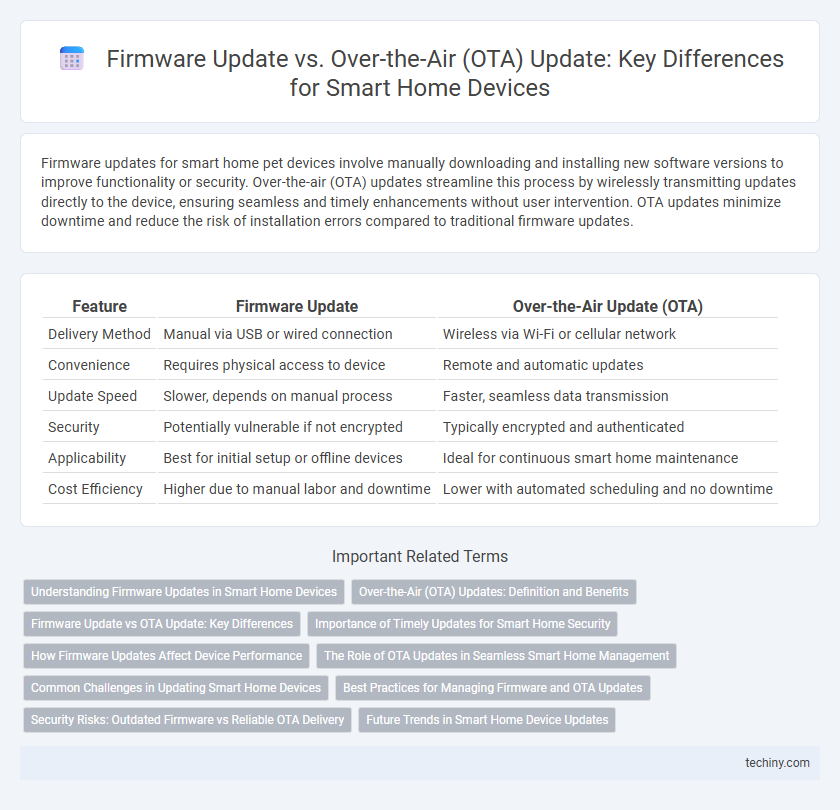Firmware updates for smart home pet devices involve manually downloading and installing new software versions to improve functionality or security. Over-the-air (OTA) updates streamline this process by wirelessly transmitting updates directly to the device, ensuring seamless and timely enhancements without user intervention. OTA updates minimize downtime and reduce the risk of installation errors compared to traditional firmware updates.
Table of Comparison
| Feature | Firmware Update | Over-the-Air Update (OTA) |
|---|---|---|
| Delivery Method | Manual via USB or wired connection | Wireless via Wi-Fi or cellular network |
| Convenience | Requires physical access to device | Remote and automatic updates |
| Update Speed | Slower, depends on manual process | Faster, seamless data transmission |
| Security | Potentially vulnerable if not encrypted | Typically encrypted and authenticated |
| Applicability | Best for initial setup or offline devices | Ideal for continuous smart home maintenance |
| Cost Efficiency | Higher due to manual labor and downtime | Lower with automated scheduling and no downtime |
Understanding Firmware Updates in Smart Home Devices
Firmware updates in smart home devices are essential for enhancing security, fixing bugs, and adding new features directly within the device's embedded system. These updates often occur over-the-air (OTA), allowing seamless wireless installation without user intervention or device disassembly. Understanding the distinction highlights that firmware updates refer specifically to the software embedded in hardware, while OTA represents the delivery method enabling remote and efficient updates in smart home ecosystems.
Over-the-Air (OTA) Updates: Definition and Benefits
Over-the-Air (OTA) updates enable smart home devices to receive firmware enhancements and security patches wirelessly, eliminating the need for manual intervention or physical connections. These updates improve device performance, increase security by addressing vulnerabilities promptly, and ensure compatibility with new features or protocols without disrupting user experience. OTA update technology is essential for maintaining the continuous reliability and longevity of smart home ecosystems.
Firmware Update vs OTA Update: Key Differences
Firmware update involves manually downloading and installing new software versions directly onto smart home devices, ensuring compatibility and security improvements are applied. Over-the-Air (OTA) update allows wireless delivery of firmware updates, enabling seamless, remote enhancements without the need for physical intervention. Key differences include OTA's convenience for large-scale deployment and real-time updates, while firmware update requires more controlled, hands-on management.
Importance of Timely Updates for Smart Home Security
Timely firmware updates and over-the-air (OTA) updates are critical for maintaining robust smart home security by patching vulnerabilities and enhancing device functionality. OTA updates provide a seamless and automated method to deliver security patches directly to smart home devices without user intervention. Ensuring regular and prompt updates minimizes the risk of cyberattacks, protecting connected devices such as smart locks, cameras, and thermostats from emerging threats.
How Firmware Updates Affect Device Performance
Firmware updates enhance smart home device performance by fixing bugs, improving security protocols, and enabling new features, which ensures smoother operation and greater reliability. Over-the-air (OTA) updates allow these firmware changes to be deployed remotely without user intervention, minimizing downtime and reducing manual maintenance. Consistent firmware updates via OTA improve device efficiency and extend lifespan by optimizing resource management and compatibility with evolving smart home ecosystems.
The Role of OTA Updates in Seamless Smart Home Management
Over-the-Air (OTA) updates play a crucial role in seamless smart home management by enabling remote firmware upgrades without user intervention, ensuring devices remain secure and function optimally. Unlike traditional firmware updates that require manual installation, OTA updates allow smart home systems to automatically deploy critical patches, feature improvements, and performance enhancements across interconnected devices. This continuous, automated process reduces downtime and enhances user convenience while maintaining the integrity of the smart home ecosystem.
Common Challenges in Updating Smart Home Devices
Firmware updates and over-the-air (OTA) updates in smart home devices often face challenges such as connectivity interruptions and compatibility issues, which can result in incomplete installations or device malfunctions. Limited bandwidth and power constraints in certain devices further complicate timely and reliable update delivery. Ensuring robust error recovery mechanisms and seamless rollback features are critical to maintaining device functionality and security during the update process.
Best Practices for Managing Firmware and OTA Updates
Effective management of firmware and over-the-air (OTA) updates in smart home devices requires robust security protocols, including end-to-end encryption and authentication mechanisms, to prevent unauthorized access. Implementing incremental update strategies minimizes bandwidth usage and reduces downtime, ensuring seamless user experience. Regularly testing update packages in controlled environments helps identify potential issues early, maintaining device stability and reliability.
Security Risks: Outdated Firmware vs Reliable OTA Delivery
Outdated firmware in smart home devices exposes vulnerabilities that hackers can exploit, leading to potential breaches and unauthorized access. Over-the-air (OTA) updates provide a secure, automated delivery method that ensures timely patching of security flaws without user intervention. Reliable OTA update protocols utilize encryption and verification mechanisms to maintain integrity and prevent malicious tampering during transmission.
Future Trends in Smart Home Device Updates
Future trends in smart home device updates emphasize seamless Over-the-Air (OTA) updates that improve security, functionality, and user experience without manual intervention. Firmware updates delivered via OTA enable devices to receive real-time patches and feature enhancements remotely, reducing downtime and maintenance costs. Advancements in AI-driven predictive update scheduling and edge computing promise even smarter, faster, and more reliable update mechanisms in the evolving smart home ecosystem.
Firmware Update vs Over-the-Air Update Infographic

 techiny.com
techiny.com